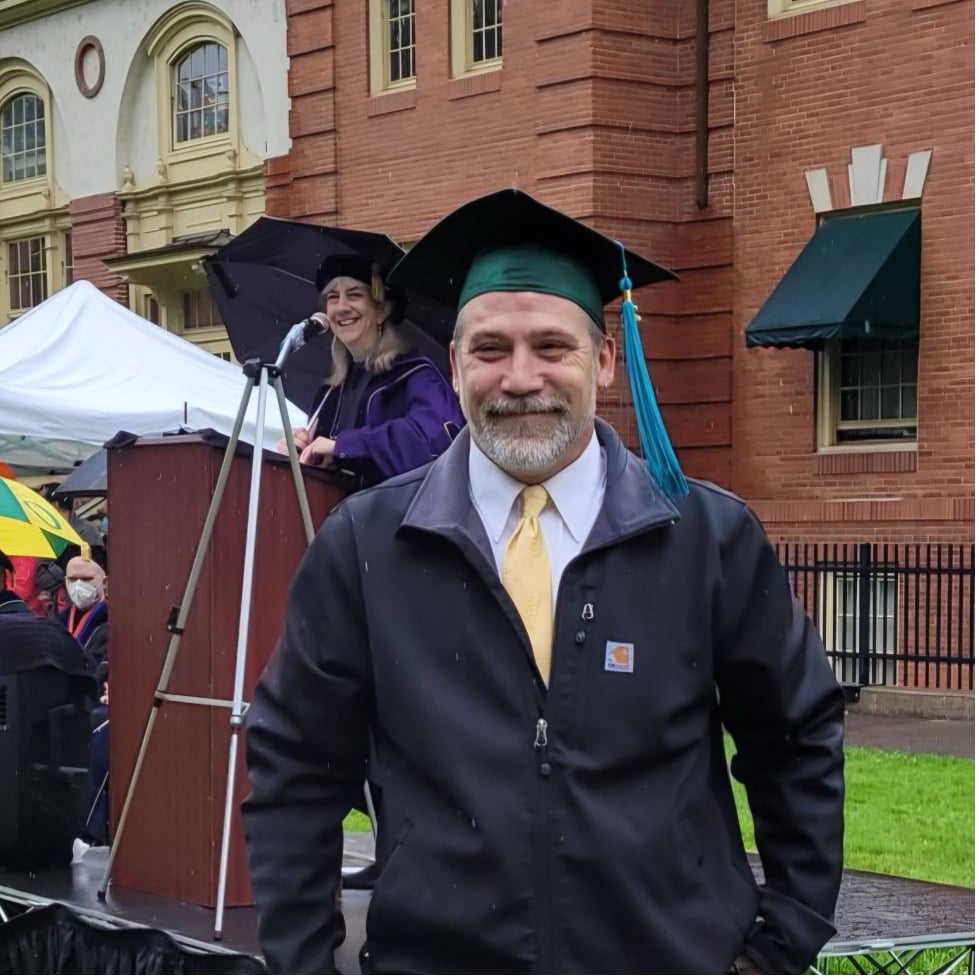When Rick Zylstra, BA ’15 (geography), MCRP ’22 (community and regional planning), entered his first year at the University of Oregon, he was unsure of what his future would hold. Coming into college as a first-generation, nontraditional student who had dropped out of high school, Zylstra found his footing at the UO when he got connected with the Sustainable City Year Program (SCYP).

Rick Zylstra celebrates earning his master's degree in community and regional planning on commencement day 2022. Photo courtesy: Rick Zylstra
Part of the UO’s Sustainable Cities Institute, SCYP was established in 2010 to give students like Zylstra hands-on experience that prepares them for the workforce, while simultaneously helping Oregon communities solve complex issues. Through year-long partnerships with an Oregon city, county, or other local government partner, SCYP participants support partner-identified projects and priorities. With many local governments facing budget shortfalls and resource challenges, SCYP strives to bridge the gap, bringing fresh perspectives to strengthen Oregon communities—all while preparing students for their careers.
Zylstra, who participated in SCYP as a student, now works as the community development director for the City of Oakridge, which is currently partnering with SCYP. As an SCYP partner liaison, Zylstra stays connected with the program, while also juggling multiple responsibilities to support the Oakridge community.
“Working for a small town, we wear many hats, so that means I have job duties across multiple disciplines,” Zylstra said. “I work administratively with the Public Works Department, within the Planning Department [working with] building permits, as well as the Building Department. It's a wide range of skill sets that you get to learn, which I really enjoy, and I have an opportunity to work on a lot of different things.”
Fifteen years of SCYP
Over the past fifteen years, SCYP has worked with more than 20 governmental partners on over 300 community projects, providing real-word experience to more than 5,000 students, many of whom are now alumni like Zylstra.In addition to SCYP’s partnership with the City of Oakridge, where the program is supporting projects such as marketing for the Oakridge Industrial Park, SCYP is also partnering with the cities of Bend, Silverton, and Gresham; the Lane Transit District (LTD); and the Salem Police Department this academic year. Projects in these communities include helping to transition a traditional, auto-centric Bend neighborhood into a mixed residential and commercial area with active transportation infrastructure, as well as supporting public relations efforts for LTD’s Long-Range Mobility Plan, LTD Connect 2045.
“Working with a variety of SCYP partners broadens our reach and allows our students to experience the diversity of Oregon cities,” said Megan Banks, Sustainable City Year Program director."

The City of Oakridge is about 40 miles east of Eugene, nestled in the foothills of the Cascade Mountains.
Photo courtesy: SCYP
A variety of cities have partnered with SCYP, such as the cities of Troutdale, Salem, Hermiston, Medford, and Sisters, with projects ranging from climate action planning, improving walkability, redevelopment considerations under new zoning standards, affordable housing, and more.
Transforming lives through career readiness

SCYP students participate in a site visit in Oakridge, focused on middle housing.
Photo courtesy: SCYP
A year into their partnership with the City of Oakridge, SCYP participants are making major headway on the community’s identified priorities, while also providing opportunities for UO alumni and current students to work together. Georgia Manning, class of 2027 (architecture), is one of this year’s SCYP student participants partnering with Zylstra.
When Manning enrolled in an SCYP class in the fall of 2024, she didn’t fully know what she was getting herself into. Before she knew it, Manning was challenged to help design plans for higher density housing and sustainable living situations within just eleven weeks.
“Tackling this problem with Oakridge, we started kind of going through how we might integrate duplexes and row houses and then apartments into the Oakridge environment,” Manning said. “Currently their code doesn't allow what they call middle density housing.”
Middle housing is considered anything between a single-family home and a large apartment complex, such as a duplex or townhouse. Middle housing can provide greater housing options for community members, often at more affordable prices, but changing longstanding city codes is a challenge—one that people like Zylstra and Manning were tasked with tackling.
"We were trying to help Rick sell the idea to the public by exploring these different types of housing,” Manning said. “As a final project, we designed a neighborhood . . . with the middle density housing. Then we presented it to Oakridge and their public and got to hear their feedback. That was really fun; we got to talk to a lot of [community members]. They were a lot more excited about the idea than I thought they were going to be.”
A large part of SCYP’s mission is to ensure residents of the communities they partner with are engaged as much as possible. Often, SCYP partners and student participants have to get buy-in from not only city officials, but community members, as well. While Manning said community meetings were intimidating on some levels, they added to the real-world experience of the program.
“It was very much about this connectivity and getting real world experience. Getting to actually talk to people that we might be designing with and understanding the impact you're going to have is very helpful. That seemed like the big picture idea we were trying to get at.”
While it can be challenging to convince a community to make a major zoning change like middle housing, Manning explains how helpful Zylstra was throughout the process.
“It was fun to get to talk to him and especially get his perspective as a city planner. All our professors and the people that we mainly talk to are usually architects, so getting his perspective as a planner and as the sole planner for all of Oakridge . . . [was great].”
Manning said SCYP made her realize how much she enjoys working with smaller communities, describing the experience as purposeful. She’s looking forward to exploring career opportunities that impact community members as she continues her education at the UO.
Making an impact for years to come
Now in its fifteenth year, SCYP is continuing to build future generations of workforce ready graduates, helping educate and train students to enter their post-grad careers, already having gained experience in local community goal setting and decision-making.These projects don’t just work with architecture and planning, public policy and management students. The program matches resources from existing university courses, including law, business, journalism, geography, planning, design, public administration, and more.
To learn more about SCYP, visit sci.uoregon.edu/scyp.
—By Olivia Arciniega, UOAA student writer/editor, class of 2026

